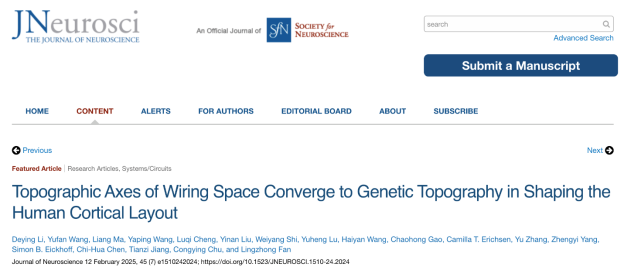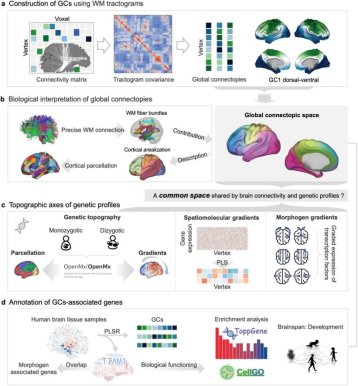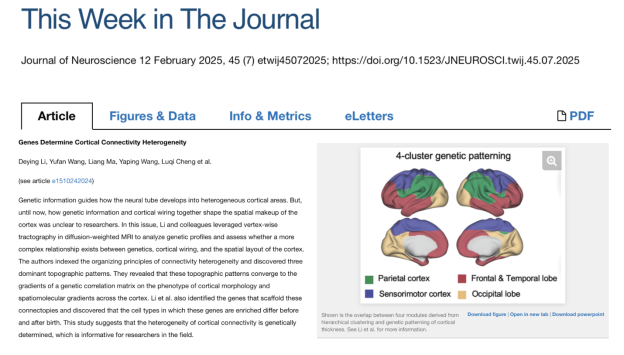The Symphony of Genes and Connectivity: Decoding the Complex Layout of the Human Cerebral Cortex
Font:【B】 【M】 【S】
The human cerebral cortex shows remarkable spatial heterogeneity in both function and structure, shaped by the combined influence of genetic factors and patterns of neural connectivity. Genetic factors play a key role by regulating gradients of signaling molecules and transcription factors during neurodevelopment, driving cortical regionalization. Meanwhile, the connectivity patterns between cortical regions reflect functional and structural differences, providing important clues for defining brain region boundaries. These connectivity patterns not only support the construction of brain network atlases but also offer essential insights into cortical parcellation. However, there remains a lack of systematic understanding of how gene expression gradients influence the wiring of subcortical white matter fibers and their spatial relationship with cortical region distributions.

Recently, a team from the Laboratory of Brain Atlas and Brain-Inspired Intelligence at the Institute of Automation, Chinese Academy of Sciences, revealed the intrinsic relationship between the topological structure of human cortical connectivity and genetic features. The study proposes that given the vast difference in the numbers of genes and connections, the relationship between genetic encoding and interregional connectivity is not a simple one-to-one mapping. Instead, it follows a more efficient organizational principle in which genes adopt specific embedded patterns across the cortex to guide the spatial wiring of white matter tracts. By integrating human connectomics and genetic data, the team identified three principal topographic axes of brain connectivity—the dorsoventral axis, anteroposterior axis, and mediolateral axis. These axes not only reflect systematic variations in intracortical connectivity but also closely align with morphogenetic and genetic gradients during embryonic development. The study, titled Topographic Axes of Wiring Space Converge to Genetic Topography in Shaping Human Cortical Layout, was published as a Featured Article in the Journal of Neuroscience and highlighted in the “This Week in The Journal” section.

Research framework diagram
Gene expression guides precise brain connectivity wiring
During embryonic development, the human brain begins construction according to a kind of “blueprint” encoded by genes. Using diffusion MRI technology, the team mapped interregional connectivity in the brain and found that connections are not randomly distributed but instead follow three principal topographic axes: dorsoventral (top-to-bottom), anteroposterior (front-to-back), and mediolateral (inside-to-outside). Based on these axes, biologically meaningful cortical parcellations can be defined. Introducing more topographic dimensions enables identification of finer cortical regions, providing further evidence for the team’s earlier research framework of “using connectivity information to parcellate and map the brain.”

Global connectivity topography distributed across the cortex
The team further explored the relationship between genes and brain connectivity, finding that the complex spatial layout of brain connections is strongly influenced by genetic factors. By deeply analyzing human gene expression data, they discovered that certain key genes show higher expression in specific cortical regions, and this spatial variation aligns with the topographic distribution of brain connectivity. For example, genes responsible for neurogenesis display gradient-like distributions during early development, guiding neuronal differentiation and migration. These genetic gradients not only define regional function but also provide directional cues for neural fiber wiring.
Among many genes, the team focused on key morphogenetic regulators such as FGF8, PAX6, and WNT3. These genes are highly active during embryonic stages, influencing brain region differentiation and neuronal connectivity patterns through signaling pathways. Interestingly, these genes continue to shape brain structure and function into adulthood, acting as “behind-the-scenes directors” in connecting multiple brain regions. This research offers a new perspective on understanding the organizational principles underlying the complexity of the human brain and provides valuable clues for exploring its mysteries.
The convergence of connectivity and genetic factors shapes cortical layout
A core result of this research is the definition of large-scale brain connectivity patterns, described as “Global Connectopy,” and the discovery of its significant alignment with gene expression. This match suggests that despite the vast difference in numbers between genes and neural connections, genes can influence complex connectivity layouts through relatively simple rules. The researchers propose that these rules follow a “gradient-driven” model, in which genes guide precise brain wiring via spatial gradients. In other words, the brain’s organization obeys a set of “invisible rules” defined by genes.
This finding suggests that low-dimensional topographic representations of anatomical connectivity can unify the interpretation of genetic information and connectional organization, offering a new perspective on brain organization. The results not only deepen our understanding of functional parcellation and the genetic basis of brain organization and function but also provide a new theoretical framework for exploring cortical regionalization, functional integration, and neural circuit formation. Moreover, by identifying key genes linked to connectivity patterns and their functions, this research provides new leads for investigating the genetic mechanisms behind neurodevelopmental disorders and brain diseases.

Connectivity and genetics converge in low-dimensional space
After publication, the paper was selected as a “This Week in the Journal” Featured Article in theJournal of Neuroscience and received special coverage. The feature noted that the work reveals the genetic basis of cortical connectivity heterogeneity and provides valuable insights for neuroscience research. During peer review, the study also received high praise from reviewers. One reviewer commented: “Their groundbreaking findings reveal a genetically orchestrated space that encodes the intricate variation in interareal connectivity, providing profound new insights into the complexities of cortical connections and the process of arealization.” Another reviewer noted: “This is timely work and an important contribution to the field that explores the relationship between underlying genetic gradients and macroscale anatomical wiring.”

Although this study made significant discoveries, it also raises new questions. How do different genes interact to shape the brain? Do environmental factors influence genetic control over brain connectivity? Future research combining higher-resolution brain imaging and more precise genetic analysis tools will aim to answer these questions. What is certain is that the interplay between brain connectivity and genes shapes the formation of the human brain. This work not only reveals the elegant rules underlying the brain’s complexity but also inspires new reflections on human potential. The brain—a marvel woven from connections and genes—still holds many secrets waiting to be uncovered in the next chapter of scientific discovery.
The paper’s first author is Deying Li, a PhD student at the Laboratory of Brain Atlas and Brain-Inspired Intelligence, Institute of Automation, Chinese Academy of Sciences. Corresponding authors are Professors Lingzhong Fan and Congying Chu. Main collaborators include Professors Tianzai Jiang, Zhengyi Yang, Assistant Researcher Weiyang Shi, Associate Professor Luqi Cheng of Guilin University of Electronic Technology, Professor Chi-Hua Chen of the University of California San Diego, Professor Simon B. Eickhoff of Forschungszentrum Jülich in Germany, Professor Yu Zhang of Zhejiang Lab, and Dr. Camilla T. Erichsen of Aarhus University in Denmark. The research was supported by the “Science and Technology Innovation 2030 – Brain Science and Brain-Inspired Research” Major Project and the National Natural Science Foundation of China.
Global Connectopy Space (GC Space)
Copyright Institute of Automation Chinese Academy of Sciences All Rights Reserved
Address: 95 Zhongguancun East Road, 100190, BEIJING, CHINA
Email:brain-ai@ia.ac.cn